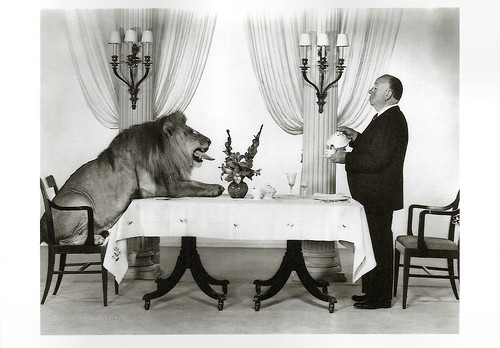
British postcard in the Black & Whites Gallery by Foto-Roff, London, no. 1255. Photo: Clarence Sinclair Bull / Kobal Collection, 1957. Caption: How many sugars?

French postcard by Editions Gendre in the Alfred Hitchcock series, no. 6. Photo: Keystone. Caption: Alfred Hitchcock and the first Pathé camera.
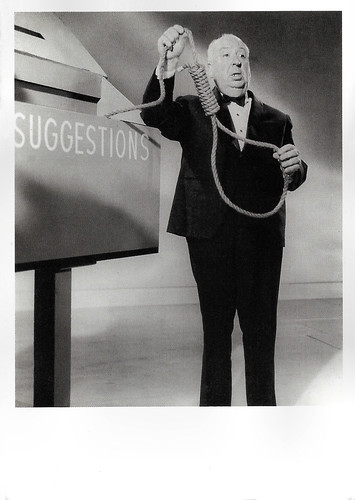
French postcard in the collection Magie Noire by Editions Hazan, no. 6489. Photo: Collection Dominique Lebrun D.R. Alfred Hitchcock promoting Rope (Alfred Hitchcock, 1948).

Swiss postcard by CVB Publishers / News Productions, Grandson, no. CP 46, 1996. Photo: Sam Shaw, 1953.
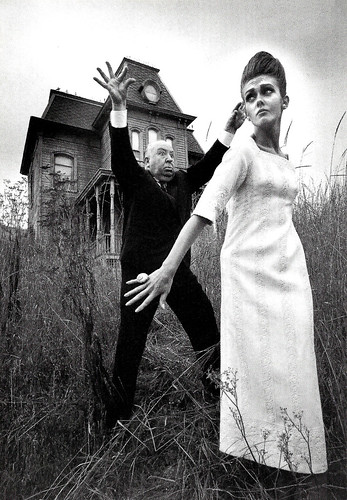
French postcard by Editions du désastre, Boulogne, no. JS 16, 1986. Photo: JeanLoup Sieff. Caption: Alfred Hitchcock. Hollywood, 1962. This photo was made at the set of Psycho (1960) for an article in Harper's Bazar. The name of the model was Ina.

French postcard in the Collection Cinéma by Editions Art & Scene, Paris, no. CA 103, 1996. Alfred Hitchcock at the set of The Birds (1963).
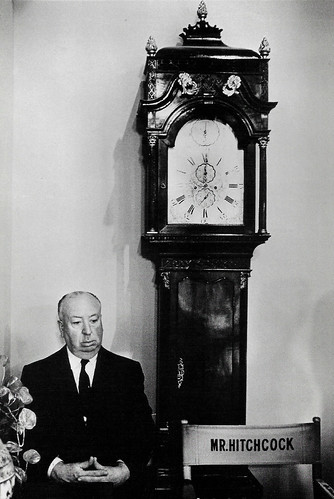
British postcard by ACME Cards, London, no. BW5. Photo: Bob Willoughby, 1964. Alfred Hitchcock on the set of Marnie (1964).
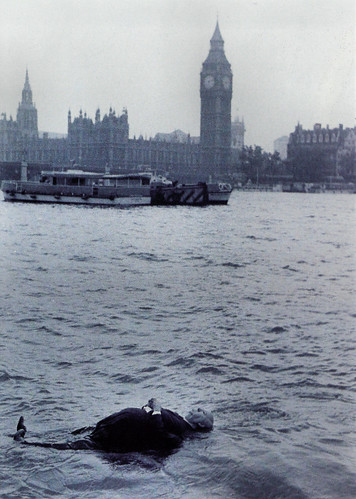
German postcard by Edition Tushita, no. B 491. Photo: Interphoto. Alfred Hitchcock in Frenzy (Alfred Hitchcock, 1972).

French postcard by Editions 'Humour à la Carte", Paris, no. ST-5. Photo: Alfred Hitchcock promoting Family Plot (Alfred Hitchcock, 1976). Sent by mail in 1986.
The quintessential English 'Hitchcock blonde'
Alfred Joseph Hitchcock was born in Leytonstone, on the outskirts of east London, in 1899. He was the son of Emma Jane Whelan and East End greengrocer William Hitchcock. His parents were both of half English and half Irish ancestry. He had two older siblings, William and Eileen Hitchcock. Raised as a strict Catholic and attending Saint Ignatius College, a school run by Jesuits, Hitch had very much of a regular upbringing.
In 1914, his father died. To support himself and his mother—his older siblings had left home by then—Hitchcock took a job in 1915 as an estimator for the Henley Telegraph and Cable Company. His interest in films began at around this time, frequently visiting the cinema and reading US trade journals.
In a trade paper, he read that Famous Players-Lasky, the production arm of Paramount Pictures, was opening a studio in London. They were planning to film 'The Sorrows of Satan' by Marie Corelli, so Hitch produced some drawings for the title cards and sent his work to the studio. They hired him, and in 1919 he began working for Islington Studios as a title-card designer.
Hitchcock soon gained experience as a co-writer, art director, and production manager on at least 18 silent films. After Hugh Croise, the director for Always Tell Your Wife (1923) fell ill, Hitchcock and star and producer Seymour Hicks finished the film together.
When Paramount pulled out of London in 1922, Hitchcock was hired as an assistant director by a new firm run in the same location by Michael Balcon, later known as Gainsborough Pictures. He began to collaborate with the editor and script girl Alma Reville, his future wife.
He worked as an assistant to director Graham Cutts on several films, including The Blackguard (1924), which was produced at the Babelsberg Studios in Potsdam. There Hitchcock watched part of the making of F. W. Murnau's film Der letzte Mann/The Last Laugh (1924). He was impressed with Murnau's work and later used many of his techniques for the set design in his own productions.
In the summer of 1925, Balcon asked Hitchcock to direct The Pleasure Garden (1925), starring Virginia Valli, a co-production of Gainsborough and the German firm Emelka. Reville, by then Hitchcock's fiancée, was assistant director-editor.
In 1927, Hitchcock made his first trademark film, the thriller The Lodger: A Story of the London Fog (1927) starring Ivor Novello. The Lodger is about the hunt for a serial killer who, wearing a black cloak and carrying a black bag, is murdering young blonde women in London, and only on Tuesdays. The Lodger was a commercial and critical success in the UK.
In the same year, Hitchcock married Alma Reville. They had one child, Patricia Hitchcock (1928). Reville became her husband's closest collaborator and wrote or co-wrote on many of his films.
Hitchcock made the transition to sound film with his tenth film, Blackmail (1929), the first British 'talkie'. Blackmail began the Hitchcock tradition of using famous landmarks as a backdrop for suspense sequences, with the climax taking place on the dome of the British Museum. He used an early sound recording as a special element of the film, stressing the word "knife" in a conversation with the woman (Anny Ondra) suspected of murder. It was followed by Murder! (1930).
In 1933 Hitchcock was once again working for Michael Balcon at Gaumont-British on The Man Who Knew Too Much (1934). It was a success. His second, The 39 Steps (1935), with Robert Donat, made him a star in the USA. It also established the quintessential English 'Hitchcock blonde' (Madeleine Carroll) as the template for his succession of ice-cold, elegant leading ladies. His next major success was The Lady Vanishes (1938), with Margaret Lockwood and Michael Redgrave. The film saw Hitchcock receive the 1938 New York Film Critics Circle Award for Best Director.

British hand-coloured postcard in the Film Partners Series, no PC 236. Photo: Gaumont British. Derrick De Marney and Nova Pilbeam in Young and Innocent/The Girl Was Young (Alfred Hitchcock, 1937).
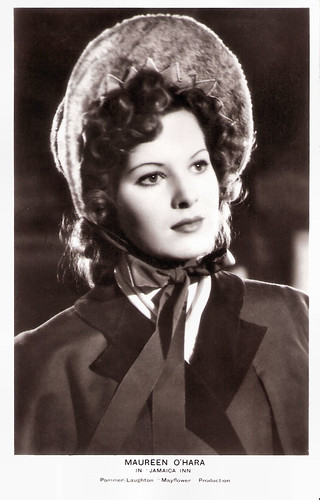
British postcard, London, no. FS 200. Photo: Pommer-Laughton 'Mayflower' production. Maureen O'Hara in Jamaica Inn (Alfred Hitchcock, 1939).
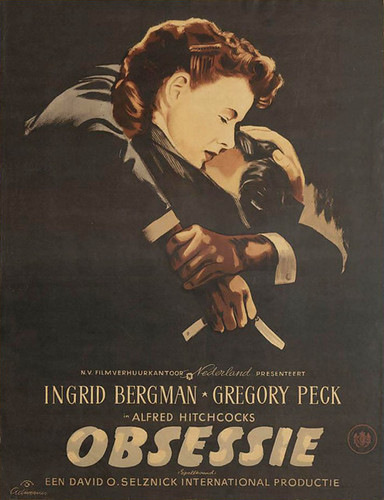
Dutch film poster by Ad Werner for the film Spellbound (Alfred Hitchcock, 1945). Pictured are Ingrid Bergman and Gregory Peck.
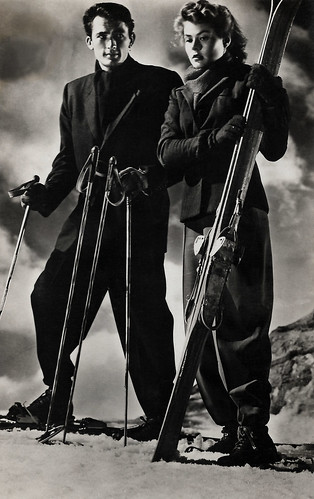
Spanish postcard, editor unknown, sent 1951. Ingrid Bergman and Gregory Peck in Spellbound (Alfred Hitchcock, 1945).

German collectors card. Photo: RKO Radio Film. Ingrid Bergman and Louis Calhern in Notorious (Alfred Hitchcock, 1946).

German collectors card. Photo: RKO Radio Film. Ingrid Bergman, Claude Rains, and Leopoldine Konstantin in Notorious (Alfred Hitchcock, 1946).

German collectors card. Photo: RKO Radio Film. Ingrid Bergman and Cary Grant in Notorious (Alfred Hitchcock, 1946).

Dutch postcard, no. a.x. 206. Photo: Film en Toneel. Ann Todd in The Paradine Case (Alfred Hitchcock, 1947).
The Pygmalion-like obsessions of a man who crafts a woman into the woman he desires
David O. Selznick signed Hitchcock to a seven-year contract beginning in March 1939, and the Hitchcocks moved to Hollywood. He directed an adaptation of Daphne du Maurier's Rebecca (1940), starring Joan Fontaine and Laurence Olivier. Rebecca won the Oscar for Best Picture, although Hitchcock himself was only nominated as Best Director.
Hitchcock's second American film was the thriller Foreign Correspondent (1940), set in Europe, and produced by Walter Wanger. It was nominated for Best Picture that year Suspicion (1941) was the first of four projects on which Cary Grant worked with Hitchcock, and it is one of the rare occasions that Grant was cast in a sinister role. In one scene Hitchcock placed a light inside a glass of milk, perhaps poisoned, that Grant is bringing to his wife, played by Joan Fontaine. The light makes sure that the audience's attention is on the glass. Fontaine won the Best Actress Oscar for her performance.
Shadow of a Doubt (1943) was Hitchcock's personal favourite. Charlotte "Charlie" Newton (Teresa Wright) suspects her beloved uncle Charlie Oakley (Joseph Cotten) of being a serial killer. Hitchcock was again nominated for the Oscar for Best Director for Lifeboat (1944) and Spellbound (1945), but he never won the award. Spellbound (1945), starring Ingrid Bergman and Gregory Peck, explores psychoanalysis and features a dream sequence designed by Salvador Dalí. Notorious (1946) stars Ingrid Bergman and Cary Grant, both Hitchcock regulars, and features a plot about Nazis, uranium, and South America.
After a brief lull of commercial success in the late 1940s, Hitchcock returned to form with Strangers on a Train (1951), based on the novel by Patricia Highsmith. In the film, two men casually meet, one of whom speculates on a foolproof method to murder. He suggests that two people, each wishing to do away with someone, should each perform the other's murder. Farley Granger played the innocent victim of the scheme, while 'boy-next-door' Robert Walker played the villain.
I Confess (1953) was set in Quebec with Montgomery Clift as a Catholic priest. It was followed by three colour films starring Grace Kelly: the 3-D film Dial M for Murder (1954), Rear Window (1954), and To Catch a Thief (1955). From 1955 to 1965, Hitchcock was the host of the television series Alfred Hitchcock Presents. With his droll delivery, gallows humour, and iconic image, the series made Hitchcock a celebrity.
In his films, Hitchcock often used the "mistaken identity" theme, such as in The Wrong Man (1956), and North by Northwest (1959). In Vertigo (1958), James Stewart plays Scottie, a former police investigator suffering from acrophobia. He develops an obsession with a woman he has been hired to shadow (Kim Novak). His obsession leads to tragedy, and this time Hitchcock does not opt for a happy ending. Vertigo is one of his most personal and revealing films, dealing with the Pygmalion-like obsessions of a man who crafts a woman into the woman he desires.
Psycho (1960) was Hitchcock's great shock masterpiece, mostly for its haunting performances by Janet Leigh and Anthony Perkins and its shower scene, and The Birds (1963) became the unintended forerunner to an onslaught of films about nature-gone-mad, and booth films were phenomenally popular. Film companies began to refer to his films as 'Alfred Hitchcock's': Alfred Hitchcock's Psycho (1960), Alfred Hitchcock's Frenzy (1972), and Alfred Hitchcock's Family Plot (1976).
During the making of Frenzy (1972), Hitchcock's wife Alma suffered a paralysing stroke which made her unable to walk very well. In 1979, Hitchcock was knighted, making him Sir Alfred Hitchcock. A year later, in 1980, he died peacefully in his sleep due to renal failure. Hitchcock was survived by his wife and daughter. After the funeral, his body was cremated. His remains were scattered over the Pacific Ocean.
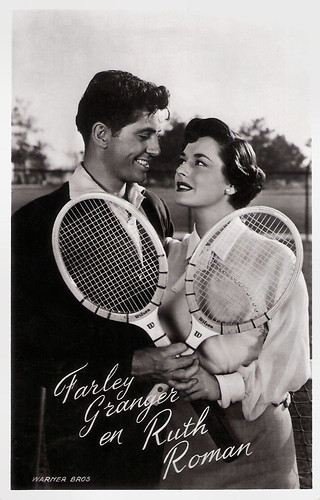
Dutch postcard by Takken, no. 566. Photo: Warner Bros. Farley Granger and Ruth Roman in Strangers on a Train (Alfred Hitchcock, 1951).
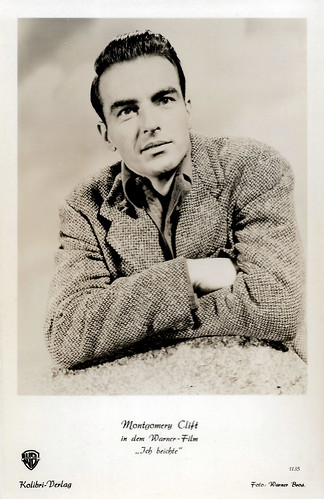
West-German by Kolibri-Verlag, no. 1135. Photo: Warner Bros. Montgomery Clift in I Confess (Alfred Hitchcock, 1953).

British postcard in the Greetings Series, A. Photo: Warner Bros. Grace Kelly in Dial M for Murder (Alfred Hitchcock, 1954).

Italian postcard by Rotalfoto, Milano, no. 552. Grace Kelly in Rear Window (Alfred Hitchcock, 1954).

Modern German postcard by K & B / Filmwelt Berlin Archiv für Film-Geschichte, no. KB 55. Photo: Paramount. Grace Kelly in To Catch a Thief (Alfred Hitchcock, 1955). Caption: Best Actress of the Year 1955.
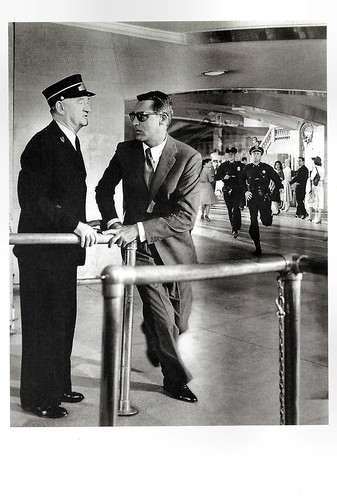
French postcard in the Collection Noire by Editions Hazan, Paris, no. 6492, 1996. Photo: Collection Dominique Lebrun D.R. Cary Grant in North by Northwest (Alfred Hitchcock, 1959).

Italian postcard by B.F.F. Edit., no. 3813. Photo: Metro-Goldwyn-Mayer. Collection: Marlene Pilaete. Eva Marie Saint (1924) was the leading lady of Alfred Hitchcock's North by Northwest (1959).

Austrian flyer (front) by Neues Film-programm, no. 2073, October 1960. Photo: Afex. Vera Miles, John Gavin, and Janet Leigh in Psycho (Alfred Hitchcock, 1960).
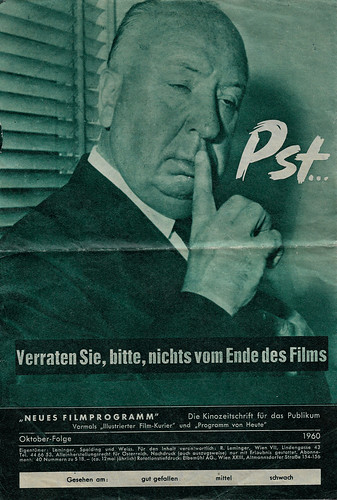
Austrian flyer (back) by Neues Film-programm, no. 2073, October 1960. Photo: Afex. Alfred Hitchcock in the trailer for Psycho (Alfred Hitchcock, 1960). Caption: Pst ... Please don't reveal anything about the end of the film.
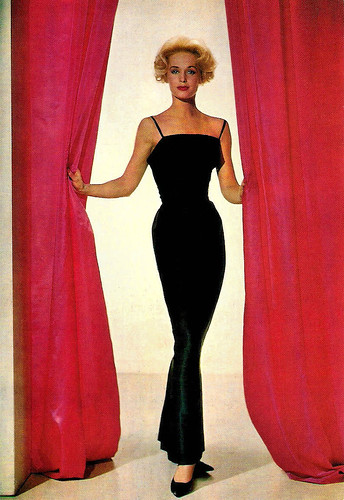
Spanish postcard by Postal Oscarcolor, S.L., no. 9. Tippi Hedren in The Birds (Alfred Hitchcock, 1963).
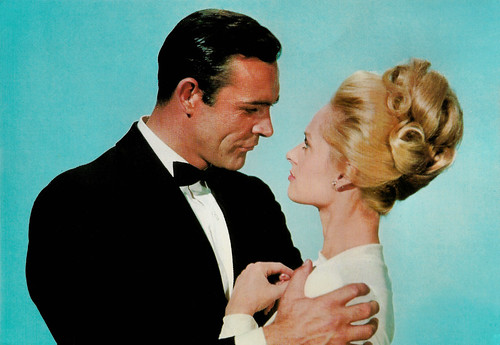
Spanish postcard by Postal Oscarcolor, no. 13. Sean Connery and Tippi Hedren in Marnie (Alfred Hitchcock, 1964).

American postcard by Fotofolio, New York, N.Y., no. PH 18, 1981. Photo: Philippe Halsman, 1962 / Hastings Galleries Collection. Alfred Hitchcock at the set of The Birds (1963).
Sources: Bruce Eder (AllMovie), Wikipedia, and IMDb.
No comments:
Post a Comment